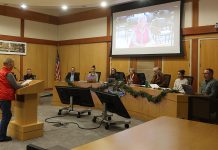
The United States (and Sonoma County) is in the middle of a tectonic opinion shift on the question of face masks. Last week, the controversy centered on the question of who should wear one — just frontline workers like doctors or nurses or everyone who goes out in public — and what masks should be made of? Are cloth masks OK?
Then in a fractious press conference, President Donald Trump announced that the CDC was recommending that members of the public should begin wearing cloth face masks to stem the spread of the coronavirus. He then announced that he personally wouldn’t be wearing a mask.
The unmasking of the America
The question of whether or not to buy a mask has been a hot topic for several months.
At the end of February, U.S. Surgeon General Jerome Adams tweeted “Seriously people – STOP BUYING MASKS! They are NOT effective in preventing general public from catching #Coronavirus, but if healthcare providers can’t get them to care for sick patients, it puts them and our communities at risk!”
While the second part of his injunction is clearly true — particularly given the chronic shortage of medical supplies thus far during the pandemic — the first part (about masks’ protective value for regular people during an epidemic) is questionable.
The logical disconnect was obvious from the start — if masks help to keep health workers safe, why wouldn’t the same principle apply to regular people waiting in crowded grocery lines or on public transit? The government’s insistence that only sick people should wear masks was equally problematic, especially once it became apparent that people could be asymptomatic but shedding virus for up to 14 days before they felt ill.
“I think that the federal authorities have been woefully unsupportive of this simple measure to reduce the spread of the virus,” said Dr. Jeff Hergenrather, a former emergency room doctor who now has a medical cannabis practice.
Who is that masked man?
Hergenrather said that while a simple cloth mask isn’t as protective as a properly fitting N95 mask, “that is not a reason to abandon it … I wear a DYI mask when I’m in public, except for walking on my property or rural country road.”
“COVID-19 is labelled a novel virus, for which much is to be learned. We know that it is frightfully contagious. Once it’s in the general population as it is now, asymptomatic patients are a huge risk to unsuspecting contacts. A mask can reduce both the exit of the virus from an infected person and reduce the entry of the virus to a healthy person.”
“Can it spread on the wind? Can it be spread on ATM machines and money? Can it be spread on furniture, clothing, railings, etc. Answers to these and other questions are yet to be fully studied, but I would assume the answer is ‘yes’. At least presume so for your own protection,” he said.
Dr. Gary Pace, who lives in Sebastopol but works as the public health officer for Lake County agrees. “If the whole community does it, it should help,” he said. “I plan to start wearing one once I get my hands on one. This is more for protection of others rather than for myself. It probably really works mainly by stopping me from spreading it before I have symptoms.”
The new recommendation from the CDC is that everyone should wear masks when they go out in public, preferably cloth masks, while keeping the precious reserves of N95 masks for health workers.
On April 1, the state of California made wearing masks optional for people who need to venture out in public.
“Cloth face coverings are not a substitute for physical distancing and washing hands and staying home when ill, but they may be helpful when combined with these primary interventions,” the announcement from the California Department of Public Health said.
Local “sewists” leap into action
While the mask debate raged among experts at the national level, a group of “sewists” in Sonoma County took matters into their own hands, inspired by the plight of health care workers in hospitals and nursing homes.
Two weeks ago, Monte Rio textile artist and businesswoman Quinn Roncarati got together with some friends and decided to sew some cloth face masks for health workers. She created a Facebook group, North Bay Sewists Unite, in hopes that a few more friends would join. Within a week, she had 1,000 volunteers, sewing away throughout the North Bay.
At first, she and a friend dropped off fabric and picked up finished masks from volunteers’ homes, but as the number of volunteers grew, that quickly proved unworkable. Now there are six or seven drop-off boxes at the homes of volunteers from Monte Rio to Marin.
“We’ve donated more than 1,000 masks,” Roncarati said. She expects to donate another 2,000 masks this week to hospitals and senior centers that have requested them.
Roncarati said her group sews from two patterns that can be worn either by themselves as cloth face masks or on top of an N95 mask. Both cloth mask patterns have slits that can be used to slide denser material inside to make the masks more germ resistant.
But you don’t have to be part of a Facebook group to sew face masks.
“I’m not part of a group or anything; I just wanted to lend a hand,” said Sebastopol’s Barbara Philipp. “The funny thing is there are so many different patterns and videos and opinions. Then the other day I went onto the Kaiser Permanente website — they actually have a page where they’re asking for certain donated items, including homemade masks — and they had a pattern and so I started making those. I figured if they want that specific thing and I make that, then my time is being well spent.”
On March 24, Kaiser Permanente announced that it would start taking donations of hand-made cloth masks, in addition to new, unopened packages of N95 masks and other personal protective gear.
Roncarati said the sewists in her group have expanded their repertoire to include hospital gowns, booties and even plastic face screens.
She said that she and the volunteers of North Bay Sewists Unite are going to keep on sewing until these items are no longer needed.
“My goal is to make so many that we’ll run out requests,” she said.








